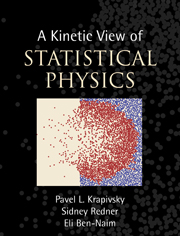13 - Diffusive reactions
Published online by Cambridge University Press: 05 March 2013
Summary
The previous chapter focused on population dynamics models, where the reactants can be viewed as perfectly mixed and the kinetics is characterized only by global densities. In this chapter, we study diffusion-controlled reactions, in which molecular diffusion limits the rate at which reactants encounter each other. In this situation, spatial gradients and spatial fluctuations play an essential role in governing the kinetics. As we shall see in this chapter, the spatial dimension plays a crucial role in determining the importance of these heterogeneities.
Role of the spatial dimension
When the spatial dimension d exceeds a critical dimension dc, diffusing molecules tend to remain well mixed. This efficient mixing stems from the transience of diffusion in high spatial dimension, which means that a molecule is almost as likely to react with a distant neighbor as with a near neighbor. Because of this efficient mixing, spatial fluctuations play a negligible role, ultimately leading to mean-field kinetics. Conversely, when d < dc, nearby particles react with high probability. This locality causes large-scale heterogeneities to develop, even when the initial state is homogeneous, that invalidate a mean-field description of the kinetics.
To illustrate the role of the spatial dimension in a simple setting, consider the evolution of a gas of identical diffusing particles that undergo either irreversible annihilation or coalescence (see also Section 1.2). Suppose that each particle has radius R and diffusivity D.
- Type
- Chapter
- Information
- A Kinetic View of Statistical Physics , pp. 404 - 440Publisher: Cambridge University PressPrint publication year: 2010



